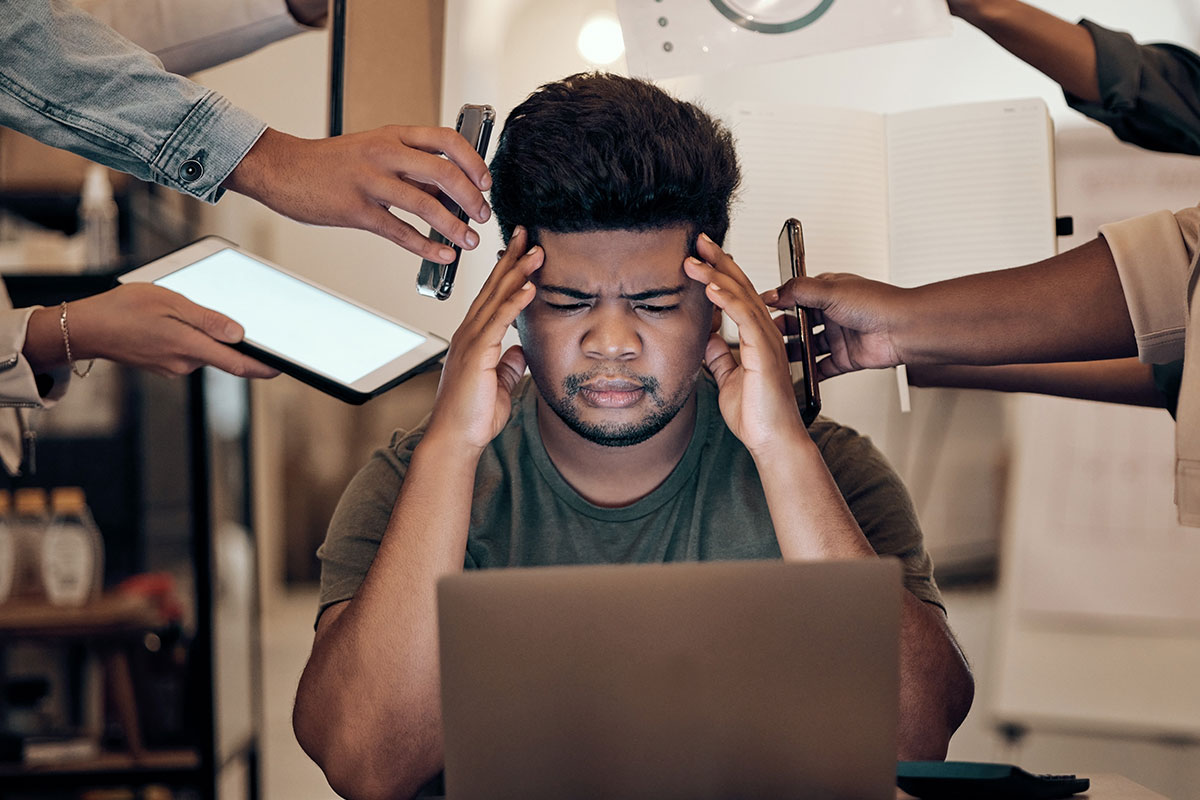Technology has become part of our everyday lives, but employees need to be aware of the impacts extensive use of technology can have on their mental health, says Laura Graves.
Even before the pandemic, a third of employees were so stressed they checked emails in the middle of the night. Eight out of ten struggled to switch off and one in five were so tired after an anxiety-ridden night’s sleep they had to take the next day off work.
With a rise in remote and hybrid working, this has blurred work-life boundaries even further, and social media, gaming and streaming services have become no less addictive. Overall employees are now spending over four hours a day on their phones, in a way that is undermining wellbeing.
In the run up to Mental Health Awareness Week (15 – 21 May) Laura Graves, one of our senior therapists, looks at the underlying anxieties driving technology addiction and five ways to help employees tackle this to protect their mental health.
Five ways to help employees tackle technology burnout
1. Recognise the underlying anxiety
Individuals can become addicted to their screens due to all sorts of reasons. Perhaps they’re anxious about pressures at work, worried they won’t be seen as committed if they’re not constantly accessible or have things in their personal life that work distracts them from.
If they’re addicted to their devices outside of work, maybe they’re scrolling social media or binge-watching streaming services to avoid thinking about money worries. Or maybe they’re gaming late into the night to avoid feeling lonely.
However, just as using drinking or gambling to forget about worries can become a negative coping strategy, so can technology addiction. Encourage employees to admit when excessive technology use is undermining their health or relationships so they can explore the underlying anxiety driving this behaviour and develop better coping strategies.
2. Get managers to lead by example
More employees than ever before are using technology to access work throughout the day and night than ever before. Although this has the power to increase flexible working and improve work-life balance, it’s also driving anxiety and burnout.
Managers can inadvertently encourage ‘always on’ cultures by sending emails later or at night or the weekend. The message is that this is what it takes to get on here. Even if the employee chooses not to respond, they will still be suffering the anxiety of hearing the pings and worry they won’t be seen as committed.
With more and more people choosing to work flexibly and pick up work after a school run or break during the day to exercise, it’s difficult to tell people when they should and shouldn’t work. Managers, therefore, need to reassure people that it’s okay to disconnect from work to recharge. Then lead by example by setting ‘do not disturb’ modes on their technology.
3. Promote greater self-care
One of the biggest consequences of technology overuse is that it reduces time for self-care. Employees might tell themselves that they’ll start eating better or exercising more once they’ve finished a project or box set, when self-care needs to be a part of daily life.
During the pandemic, employees were very mindful about utilising time freed up from their commute to exercise or enjoy healthier meals. Now most employees are using technology to extend their day in unhealthy ways, such as sending work emails before they get out of bed instead.
Humans thrive on routine, so encourage employees to still get dressed, eat and even walk to work before they connect to work. Even if they work from home, a brisk walk around the block, instead of allowing technology to make keep them sedentary, can significantly reduce the risk of heart disease and cancer and boost energy levels and productivity.
4. Help to break unhealthy habits
Even when employees want to use technology more healthily, it can still be difficult to break bad habits. Such as dipping into work emails or WhatsApp messages unnecessarily, binge-watching box sets late at night or scrolling social media before going to bed.
Share insights and tools on how to break unhealthy habits and create positive behaviour change. Our PAM Assist Wellbeing app includes access to online CBT, mindfulness courses and goal setting and habit tracking.
Employees are accountable for their own actions, but sharing resources on the mental health benefits of mindfulness and turning off push notifications can be helpful. You could also create a team wellbeing challenge to encourage employees to set a digital curfew, after which all electronic devices get switched off. Not only will this improve their sleep and reduce anxiety levels, it will start a conversation about technology and mental health.
5. Check-in with employees
Signs that an employee is struggling with technology burnout includes patterns of them not engaging as much, changes to their physical appearance, increased forgetfulness or brain fog and increased procrastination. They might be scrolling through their phone a lot to avoid doing a task they feel anxious about when this only increases the pressure in the long run.
If their manager notices any of these warning signs, they should arrange a ‘check in chat’ with the employee to talk about how they’re feeling and if there’s anything they’re struggling with. They can observe that they haven’t been themselves and ask if everything is okay?
Their role isn’t to counsellor or advise the employee but listen with empathy and direct them towards appropriate support services. Where someone is really struggling with technology addiction, or an underlying anxiety driving this, managers might be able to proactively refer the employee to any mental health support services in place for therapy to address this.
Laura Graves is a senior therapist for PAM Wellbeing
How can PAM Wellbeing help?
Employee Assistance Programme (EAP): Provide employees with confidential access to counsellors, financial and legal support to help them address underlying anxieties driving negative use of technology. Find out more
Manager referred employee counselling (stepped care): Empower managers with the opportunity to proactively refer employees who are struggling into psychological support services, such as CBT and EMDR. Find out more
PAM Assist Wellbeing App: Support employees to break unhealthy habits and create positive behaviour change with access to online CBT, mindfulness courses and goal setting and habit tracking. Find out more
Why not set up a free consultation to discuss your needs? Please call 01925 596244 or email salesenquiries@pamwellbeing.co.uk.
Sources
Third of Brits are so stressed they have checked work emails in middle of night
Technostress’ | The impact of work tech on our mental wellbeing




